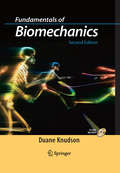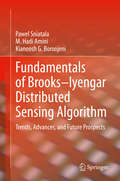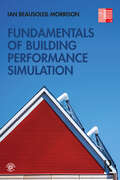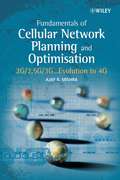- Table View
- List View
Fundamentals of Bias Temperature Instability in MOS Transistors: Characterization Methods, Process and Materials Impact, DC and AC Modeling (Springer Series in Advanced Microelectronics #52)
by Souvik MahapatraThis book aims to cover different aspects of Bias Temperature Instability (BTI). BTI remains as an important reliability concern for CMOS transistors and circuits. Development of BTI resilient technology relies on utilizing artefact-free stress and measurement methods and suitable physics-based models for accurate determination of degradation at end-of-life and understanding the gate insulator process impact on BTI. This book discusses different ultra-fast characterization techniques for recovery artefact free BTI measurements. It also covers different direct measurements techniques to access pre-existing and newly generated gate insulator traps responsible for BTI. The book provides a consistent physical framework for NBTI and PBTI respectively for p- and n- channel MOSFETs, consisting of trap generation and trapping. A physics-based compact model is presented to estimate measured BTI degradation in planar Si MOSFETs having differently processed SiON and HKMG gate insulators, in planar SiGe MOSFETs and also in Si FinFETs. The contents also include a detailed investigation of the gate insulator process dependence of BTI in differently processed SiON and HKMG MOSFETs. The book then goes on to discuss Reaction-Diffusion (RD) model to estimate generation of new traps for DC and AC NBTI stress and Transient Trap Occupancy Model (TTOM) to estimate charge occupancy of generated traps and their contribution to BTI degradation. Finally, a comprehensive NBTI modeling framework including TTOM enabled RD model and hole trapping to predict time evolution of BTI degradation and recovery during and after DC stress for different stress and recovery biases and temperature, during consecutive arbitrary stress and recovery cycles and during AC stress at different frequency and duty cycle. The contents of this book should prove useful to academia and professionals alike.
Fundamentals of Bidirectional Transmission over a Single Optical Fibre (Solid-State Science and Technology Library #2)
by M.O. van DeventerBidirectional transmission over optical fibre networks may yield a large cost reduction because of the reduction of the network infrastructure by a factor two and the potential cost reduction by an integrated transceiver design. It may also provide a cost-effective way to upgrade distribution networks by adding bidirectional channels. This book is the first to provide a comprehensive overview of bidirectional transmission in optical networks. It handles physical aspects: the behaviour of the fibre itself in bidirectional transmission transmission aspects: the behaviour and design of bidirectional systems and network aspects: the influence of bidirectional transmission on network design. £/LIST£ Practical guidelines are also given for bidirectional system design. Audience:This book is aimed at designers, builders and operators of optical networks, e.g. the manufacturers of optical transmission systems, public-network operators, developers of local-area networks, cable-television operators, etcetera. The intended level of readership is graduate level in physics or electrical engineering.
Fundamentals of Biofilm Research
by Haluk Beyenal Zbigniew LewandowskiThe six years that have passed since the publication of the first edition have brought significant advances in both biofilm research and biofilm engineering, which have matured to the extent that biofilm-based technologies are now being designed and implemented. As a result, many chapters have been updated and expanded with the addition of sections
Fundamentals of Biofuel Production Processes
by Debabrata Das Jhansi L. VaranasiFocusing on fundamentals of biofuel production from renewable energy sources and biohydrogen production, this book offers a complete understanding of the bioconversion processes. Each chapter begins with a fundamental explanation for general readers and ends with in-depth scientific details suitable for expert readers. It discusses different types of production technologies covering basic concepts, production strategies, commercial usage, and advances.
Fundamentals of Biofuel Production Processes
by Debabrata Das Jhansi L. VaranasiFocusing on fundamentals of biofuel production from renewable energy sources and biohydrogen production, this book offers a complete understanding of the bioconversion processes. Each chapter begins with a fundamental explanation for general readers and ends with in-depth scientific details suitable for expert readers. It discusses different types of production technologies covering basic concepts, production strategies, commercial usage, and advances.
Fundamentals of Biomaterials: An Introduction
by Vasif Hasirci Nesrin HasirciThis text for advanced undergraduate and graduate students covers the fundamental relationships between the structure and properties of materials and biological tissues. The successful integration of material and biological properties, shape, and architecture to engineer a wide range of optimized designs for specific functions is the ultimate aim of a biomaterials scientist. Relevant examples illustrate the intrinsic and tailored properties of metal, ceramic, polymeric, carbon-derived, composite, and naturally derived biomaterials.Fundamentals of Biomaterials is written in a single voice, ensuring clarity and continuity of the text and content. As a result, the reader will be gradually familiarized with the field, starting with materials and their properties and eventually leading to critical interactions with the host environment. Classical and novel examples illuminate topics from basic material properties to tissue engineering, nanobiomaterials, and guided tissue regeneration.This comprehensive and engaging text:integrates materials and biological properties to understand biomaterials function and designprovides the basics of biological tissue components and hierarchyincludes recent topics from tissue engineering and guided tissue regeneration to nanoarchitecture of biomaterials and their surfacescontains perspectives/case studies from widely-recognized experts in the fieldfeatures chapter-ending summaries to help readers to identify the key, take-home messages.
Fundamentals of Biomaterials
by Vasif Hasirci Nesrin HasirciThis comprehensive and engaging text, now in an expanded second edition, is meant for advanced undergraduate and graduate students and covers the fundamental relationships between the structure and properties of materials and biological tissues. The successful integration of material and biological properties, shape, and architecture to engineer a wide range of optimized designs for specific functions is the ultimate aim of a biomaterials scientist. Relevant examples illustrate the intrinsic and tailored properties of metallic, ceramic, polymeric, carbon-derived, naturally-derived, and composite biomaterials. Information about translation of biomaterials to clinical medical devices is included. Fundamentals of Biomaterials, 2nd Ed. is written in a single voice, ensuring clarity and continuity of the text and content. As a result, the reader will be gradually familiarized with the field, starting with materials and their basic properties and eventually leading to critical interactions with the host environment. The authors also present new topics such as tissue engineering, guided tissue regeneration, and nano- and micro- architecture of biomaterial surfaces. Full of important medical and biological definitions, essential applications, detailed examples, and interesting chapter-ending summaries, this book serves as an incredibly useful teaching text and as a modern introduction to biomaterials research. This second edition includes new chapters on the historical development of biomaterials, transplants and implants, characterization techniques, and biomedical device production, as well as an expanded chapter on human biology that now also includes biological systems (cardiovascular, respiratory, digestive, nervous, etc.), plus much more.
Fundamentals of Biomaterials: A Supplementary Textbook
by Nabisab Mujawar Mubarak Mahmood Anwar Sujan Debnath Izman SudinThis book encompasses Materials Engineering with Medical Science which introduces the depth of knowledge from beginning with relevant fundamentals. This book fills the void which comprises a broad range of Materials Engineering with Medical science, from atomic physics to histology. This book greatly benefits towards those engineering students who are least familiar with biological science as well as medical science.
Fundamentals of Biomechanics
by Ronald L. HustonIn the last three or four decades, studies of biomechanics have expanded from simple topical applications of elementary mechanics to entire areas of study. Studies and research in biomechanics now exceed those in basic mechanics itself, underlining the continuing and increasing importance of this area of study. With an emphasis on biodynamic modeli
Fundamentals of Biomechanics
by Duane KnudsonBlending up-to-date biomechanical knowledge with professional application knowledge, this second edition presents a clear, conceptual approach to understanding biomechanics within the context of the qualitative analysis of human movement. It develops nine principles of biomechanics, which provide an applied structure for biomechanical concepts, and the application of each principle is fully explored in several chapters. The book also offers real-world examples of the application of biomechanics, which emphasize how biomechanics is integrated with the other subdisciplines of kinesiology to contribute to qualitative analysis of human movement.
Fundamentals of Biomechanics
by Duane KnudsonBlending up-to-date biomechanical knowledge with professional application knowledge, this second edition presents a clear, conceptual approach to understanding biomechanics within the context of the qualitative analysis of human movement. It develops nine principles of biomechanics, which provide an applied structure for biomechanical concepts, and the application of each principle is fully explored in several chapters. The book also offers real-world examples of the application of biomechanics, which emphasize how biomechanics is integrated with the other subdisciplines of kinesiology to contribute to qualitative analysis of human movement.
Fundamentals of Biomechanics: Equilibrium, Motion, and Deformation
by Nihat Özkaya Dawn Leger David Goldsheyder Margareta NordinThis textbook integrates the classic fields of mechanics—statics, dynamics, and strength of materials—using examples from biology and medicine. The book is excellent for teaching either undergraduates in biomedical engineering programs or health care professionals studying biomechanics at the graduate level. Extensively revised from a successful third edition, Fundamentals of Biomechanics features a wealth of clear illustrations, numerous worked examples, and many problem sets. The book provides the quantitative perspective missing from more descriptive texts, without requiring an advanced background in mathematics. It will be welcomed for use in courses such as biomechanics and orthopedics, rehabilitation and industrial engineering, and occupational or sports medicine.This book:Introduces the fundamental concepts, principles, and methods that must be understood to begin the study of biomechanicsReinforces basic principles of biomechanics with repetitive exercises in class and homework assignments given throughout the textbookIncludes over 100 new problem sets with solutions and illustrations
Fundamentals of Biomedical Transport Processes (Synthesis Lectures on Biomedical Engineering)
by Gerald MillerTransport processes represent important life-sustaining elements in all humans. These include mass transfer processes, including gas exchange in the lungs, transport across capillaries and alveoli, transport across the kidneys, and transport across cell membranes. These mass transfer processes affect how oxygen and carbon dioxide are exchanged in your bloodstream, how metabolic waste products are removed from your blood, how nutrients are transported to tissues, and how all cells function throughout the body. A discussion of kidney dialysis and gas exchange mechanisms is included. Another element in biomedical transport processes is that of momentum transport and fluid flow. This describes how blood is propelled from the heart and throughout the cardiovascular system, how blood elements affect the body, including gas exchange, infection control, clotting of blood, and blood flow resistance, which affects cardiac work. A discussion of the measurement of the blood resistance to flow (viscosity), blood flow, and pressure is also included. A third element in transport processes in the human body is that of heat transfer, including heat transfer inside the body towards the periphery as well as heat transfer from the body to the environment. A discussion of temperature measurements and body protection in extreme heat conditions is also included. Table of Contents: Biomedical Mass Transport / Biofluid Mechanics and Momentum Transport / Biomedical Heat Transport
Fundamentals of Brooks–Iyengar Distributed Sensing Algorithm: Trends, Advances, and Future Prospects
by Kianoosh G. Boroojeni M. Hadi Amini Pawel SniatalaThis book provides a comprehensive analysis of Brooks-Iyengar Distributed Sensing Algorithm, which brings together the power of Byzantine Agreement and sensor fusion in building a fault-tolerant distributed sensor network. The authors analyze its long-term impacts, advances, and future prospects. The book starts by discussing the Brooks-Iyengar algorithm, which has made significant impact since its initial publication in 1996. The authors show how the technique has been applied in many domains such as software reliability, distributed systems and OS development, etc. The book exemplifies how the algorithm has enhanced new real-time features by adding fault-tolerant capabilities for many applications. The authors posit that the Brooks-Iyengar Algorithm will to continue to be used where fault-tolerant solutions are needed in redundancy system scenarios.This book celebrates S.S. Iyengar's accomplishments that led to his 2019 Institute of Electrical and Electronics Engineers' (IEEE) Cybermatics Congress "Test of Time Award" for his work on creating Brooks-Iyengar Algorithm and its impact in advancing modern computing.
Fundamentals of Building Performance Simulation
by Ian Beausoleil-MorrisonFundamentals of Building Performance Simulation pares the theory and practice of a multi-disciplinary field to the essentials for classroom learning and real-world applications. Authored by a veteran educator and researcher, this textbook equips graduate students and emerging and established professionals in engineering and architecture to predict and optimize buildings’ energy use. It employs an innovative pedagogical approach, introducing new concepts and skills through previously mastered ones and deepening understanding of familiar themes by means of new material. Covering topics from indoor airflow to the effects of the weather, the book’s 19 chapters empower learners to: Understand the models and assumptions underlying popular BPS tools Compare models, simulations, and modelling tools and make appropriate selections Recognize the effects of modelling choices and input data on simulation predictions And more. Each subject is introduced without reference to particular modelling tools, while practice problems at the end of each chapter provide hands-on experience with the tools of the reader’s choice. Curated reading lists orient beginners in a vast, cross-disciplinary literature, and the critical thinking skills stressed throughout prepare them to make contributions of their own. Fundamentals of Building Performance Simulation provides a much-needed resource for new and aspiring members of the building science community.
Fundamentals of Building Performance Simulation
by Ian Beausoleil-MorrisonFundamentals of Building Performance Simulation pares the theory and practice of a multi-disciplinary field to the essentials for classroom learning and real-world applications. Authored by a veteran educator and researcher, this textbook equips graduate students and emerging and established professionals in engineering and architecture to predict and optimize buildings’ energy use. It employs an innovative pedagogical approach, introducing new concepts and skills through previously mastered ones and deepening understanding of familiar themes by means of new material. Covering topics from indoor airflow to the effects of the weather, the book’s 19 chapters empower learners to: Understand the models and assumptions underlying popular BPS tools Compare models, simulations, and modelling tools and make appropriate selections Recognize the effects of modelling choices and input data on simulation predictions And more. Each subject is introduced without reference to particular modelling tools, while practice problems at the end of each chapter provide hands-on experience with the tools of the reader’s choice. Curated reading lists orient beginners in a vast, cross-disciplinary literature, and the critical thinking skills stressed throughout prepare them to make contributions of their own. Fundamentals of Building Performance Simulation provides a much-needed resource for new and aspiring members of the building science community.
Fundamentals of Capturing and Processing Drone Imagery and Data
by Amy E. Frazier Kunwar K. SinghUnmanned aircraft systems (UAS) are rapidly emerging as flexible platforms for capturing imagery and other data across the sciences. Many colleges and universities are developing courses on UAS-based data acquisition. Fundamentals of Capturing and Processing Drone Imagery and Data is a comprehensive, introductory text on how to use unmanned aircraft systems for data capture and analysis. It provides best practices for planning data capture missions and hands-on learning modules geared toward UAS data collection, processing, and applications. FEATURES Lays out a step-by-step approach to identify relevant tools and methods for UAS data/image acquisition and processing. Provides practical hands-on knowledge with visual interpretation, well-organized and designed for a typical 16-week UAS course offered on college and university campuses. Suitable for all levels of readers and does not require prior knowledge of UAS, remote sensing, digital image processing, or geospatial analytics. Includes real-world environmental applications along with data interpretations and software used; exercises in chapters 8 through 19 have support materials for free download. Combines the expertise of a wide range of UAS researchers and practitioners across the geospatial sciences. This book provides a general introduction to drones along with a series of hands-on exercises that students and researchers can engage with to learn to integrate drone data into real-world applications. No prior background in remote sensing, GIS, or drone knowledge is needed to use this book. Readers will learn to process different types of UAS imagery for applications (such as precision agriculture, forestry, urban landscapes) and apply this knowledge in environmental monitoring and land-use studies.
Fundamentals of Capturing and Processing Drone Imagery and Data
by Amy E. Frazier Kunwar K. SinghUnmanned aircraft systems (UAS) are rapidly emerging as flexible platforms for capturing imagery and other data across the sciences. Many colleges and universities are developing courses on UAS-based data acquisition. Fundamentals of Capturing and Processing Drone Imagery and Data is a comprehensive, introductory text on how to use unmanned aircraft systems for data capture and analysis. It provides best practices for planning data capture missions and hands-on learning modules geared toward UAS data collection, processing, and applications. FEATURES Lays out a step-by-step approach to identify relevant tools and methods for UAS data/image acquisition and processing. Provides practical hands-on knowledge with visual interpretation, well-organized and designed for a typical 16-week UAS course offered on college and university campuses. Suitable for all levels of readers and does not require prior knowledge of UAS, remote sensing, digital image processing, or geospatial analytics. Includes real-world environmental applications along with data interpretations and software used; exercises in chapters 8 through 19 have support materials for free download. Combines the expertise of a wide range of UAS researchers and practitioners across the geospatial sciences. This book provides a general introduction to drones along with a series of hands-on exercises that students and researchers can engage with to learn to integrate drone data into real-world applications. No prior background in remote sensing, GIS, or drone knowledge is needed to use this book. Readers will learn to process different types of UAS imagery for applications (such as precision agriculture, forestry, urban landscapes) and apply this knowledge in environmental monitoring and land-use studies.
Fundamentals of Cavitation (Fluid Mechanics and Its Applications #76)
by Jean-Pierre Franc Jean-Marie MichelThis book treats cavitation, which is a unique phenomenon in the field of hyd- dynamics, although it can occur in any hydraulic machinery such as pumps, propellers, artificial hearts, and so forth. Cavitation is generated not only in water, but also in any kind of fluid, such as liquid hydrogen. The generation of cavitation can cause severe damage in hydraulic machinery. Therefore, the prevention of cavitation is an important concern for designers of hydraulic machinery. On the contrary, there is great potential to utilize cavitation in various important applications, such as environmental protection. There have been several books published on cavitation, including one by the same authors. This book differs from those previous ones, in that it is both more physical and more theoretical. Any theoretical explanation of the cavitation phenomenon is rather difficult, but the authors have succeeded in explaining it very well, and a reader can follow the equations easily. It is an advantage in reading this book to have some understanding of the physics of cavitation. Therefore, this book is not an introductory text, but a book for more advanced study. However, this does not mean that this book is too difficult for a beginner, because it explains the cavitation phenomenon using many figures. Therefore, even a beginner on cavitation can read and can understand what cavitation is. If the student studies through this book (with patience), he or she can become an expert on the physics of cavitation.
Fundamentals of Cell Immobilisation Biotechnology (Focus on Biotechnology #8A)
by Viktor Nedovic Ronnie WillaertCell Immobilisation Biotechnology Biotechnology is divided into two volumes. The first volume is dedicated to fundamental aspects of cell immobilisation while the second volume deals with the diverse applications of this technology. The first volume, Fundamentals of Cell Immobilisation Biotechnology, comprises 26 chapters arranged into four parts: Materials for cell immobilisation/encapsulation, Methods and technologies for cell immobilisation/encapsulation, Carrier characterisation and bioreactor design, and Physiology of immobilised cells: techniques and mathematical modelling.
Fundamentals of Cellular Network Planning and Optimisation: 2G/2.5G/3G... Evolution to 4G
by Ajay R. Mishra“By 2008, some 2 billion people will be using mobile phones and devices, in many cases to access advanced data services. Against this backdrop, the need for efficient and effective network design will be critical to the success of increasingly complex mobile networks.” Simon Beresford-Wylie (SVP, Nokia Networks) With the complexity of the cellular networks increasing day by day, a deeper understanding of the design and performance of end-to-end cellular networks is required. Moreover, all the types of networks from 2G-2.5G-3G seem to co-exist. Fundamentals of Cellular Network Planning and Optimisation covers end-to-end network planning and optimisation aspects from second generation GSM to third generation WCDMA networks including GPRS and EDGE networks. All the sub-systems of the network i.e. radio network, transmission network and core network have been covered with focus on both practical and theoretical issues. By bringing all these concepts under one cover, this book becomes essential reading for the network design engineers working either with cellular service vendors or operators, experts/scientists working on end-to-end issues and undergraduate/post-graduate students. Key Highlights: Distinctly divided into four parts: 2G (GSM), 2.5G (GPRS & EDGE), 3G (WCDMA) and introduction to 4G (OFDM, ALL-IP, WLAN Overview) respectively Each part focuses on the radio, transmission and core networks. Concentrates on cellular network planning process and explains the underlying principles behind the planning and optimizing of the cellular networks. The text will serve as a handbook for anyone engaged in the study, design, deployment and business of cellular networks.
Fundamentals of Ceramics (Series In Materials Science And Engineering Ser.)
by Michel BarsoumUpdated and improved, this revised edition of Michel Barsoum's classic text Fundamentals of Ceramics presents readers with an exceptionally clear and comprehensive introduction to ceramic science. Barsoum offers introductory coverage of ceramics, their structures, and properties, with a distinct emphasis on solid state physics and chemistry. Key eq
Fundamentals of Ceramics (Series in Materials Science and Engineering)
by Michel BarsoumFundamentals of Ceramics presents readers with an exceptionally clear and comprehensive introduction to ceramic science. This Second Edition updates problems and adds more worked examples, as well as adding new chapter sections on Computational Materials Science and Case Studies. The Computational Materials Science sections describe how today density functional theory and molecular dynamics calculations can shed valuable light on properties, especially ones that are not easy to measure or visualize otherwise such as surface energies, elastic constants, point defect energies, phonon modes, etc. The Case Studies sections focus more on applications, such as solid oxide fuel cells, optical fibers, alumina forming materials, ultra-strong and thin glasses, glass-ceramics, strong and tough ceramics, fiber-reinforced ceramic matrix composites, thermal barrier coatings, the space shuttle tiles, electrochemical impedance spectroscopy, two-dimensional solids, field-assisted and microwave sintering, colossal magnetoresistance, among others.
Fundamentals of Ceramics (Series in Materials Science and Engineering)
by Michel BarsoumFundamentals of Ceramics presents readers with an exceptionally clear and comprehensive introduction to ceramic science. This Second Edition updates problems and adds more worked examples, as well as adding new chapter sections on Computational Materials Science and Case Studies. The Computational Materials Science sections describe how today density functional theory and molecular dynamics calculations can shed valuable light on properties, especially ones that are not easy to measure or visualize otherwise such as surface energies, elastic constants, point defect energies, phonon modes, etc. The Case Studies sections focus more on applications, such as solid oxide fuel cells, optical fibers, alumina forming materials, ultra-strong and thin glasses, glass-ceramics, strong and tough ceramics, fiber-reinforced ceramic matrix composites, thermal barrier coatings, the space shuttle tiles, electrochemical impedance spectroscopy, two-dimensional solids, field-assisted and microwave sintering, colossal magnetoresistance, among others.




















